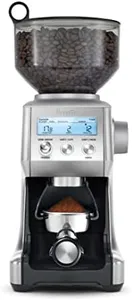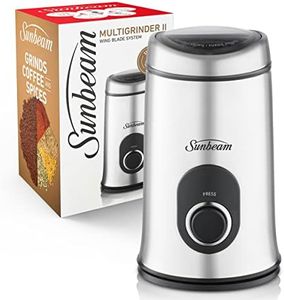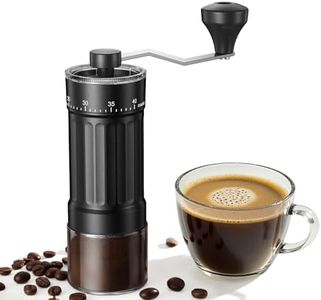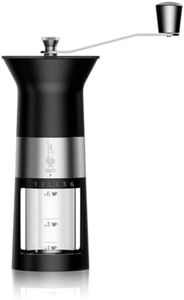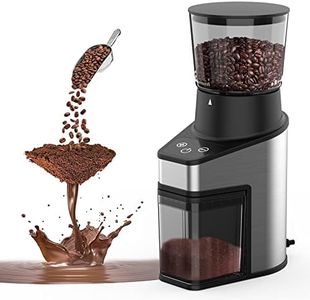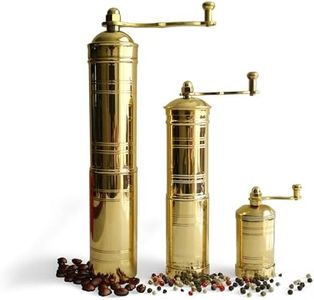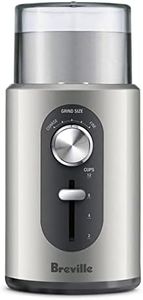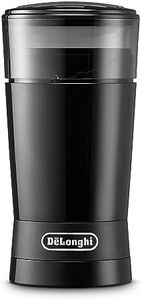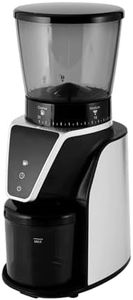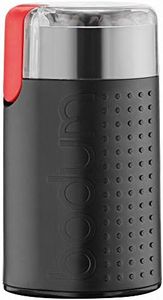We Use CookiesWe use cookies to enhance the security, performance,
functionality and for analytical and promotional activities. By continuing to browse this site you
are agreeing to our privacy policy
10 Best Turkish Coffee Grinders
From leading brands and best sellers available on the web.Buying Guide for the Best Turkish Coffee Grinders
Choosing a Turkish coffee grinder is a bit different from picking other coffee grinders. Turkish coffee requires an extremely fine, almost powdery grind that can only be achieved with certain types of grinders. It's important to understand what makes a grinder suitable for Turkish coffee and how each key specification influences your brewing experience. Knowing your preferences, how much coffee you plan to make, and how traditional you want your process to be will all help guide your decision.Grind FinenessGrind fineness is arguably the most important feature for a Turkish coffee grinder. For Turkish coffee, you need a grind that is much finer than espresso – almost like powdered sugar. Not all grinders can achieve this. Some grinders may claim to be 'fine,' but still fall short of the powdery texture required. If you want authentic Turkish coffee, make sure the grinder can reach a true Turkish grind. Manual (hand) grinders designed specifically for Turkish coffee often excel here, as do a few high-quality electric models with dedicated Turkish settings. For those who enjoy traditional authenticity or only make small portions, a manual grinder can be ideal, but if you need speed and consistency for larger batches, look for electric options that clearly specify Turkish grind capability.
Grinder TypeThere are two common types of grinders for Turkish coffee: manual (hand-cranked) and electric. Manual grinders are traditional, quiet, portable, and can achieve a very fine grind, but they require effort and time. Electric grinders are faster and more convenient, but not all can achieve the fine grind needed. If you enjoy the ritual and hands-on process, or if you often travel, a manual grinder is a great choice. If you value speed and convenience, look for an electric grinder that is specifically designed to go fine enough for Turkish coffee.
Burr MaterialThe burr material affects grinding consistency and durability. Most Turkish coffee grinders have either steel or ceramic burrs. Steel burrs are strong and grind quickly, whereas ceramic burrs can last longer and produce less heat, which preserves flavor. Both types work well for Turkish coffee if the grinder is built for ultra-fine grinding. If you want something traditional and long-lasting, ceramic may appeal to you, but steel is also a robust choice and often requires less force.
Adjustment MechanismGrinders have different mechanisms to adjust the grind size. Some use a simple screw or knob, while others have marked settings. For Turkish coffee, you typically want the finest setting, so it’s important the adjustment mechanism allows you to make very small changes. If you might use the grinder for other brewing methods too, a wider range of adjustment might be beneficial. If you'll use it only for Turkish coffee, just ensure it reliably produces the finest possible grind.
CapacityCapacity refers to how much coffee the grinder can hold and grind at once. Manual grinders usually have a smaller capacity, which is perfect if you make coffee for one or two people. Electric grinders can often handle more at a time. If you brew for a group or want to save time, a larger capacity might be important. However, for single servings and freshness, a small grinder is often best.
Build Quality and MaterialsThe overall build quality and the materials used in the grinder affect its durability, style, and how easy it is to clean. Brass, copper, stainless steel, and sometimes wood feature in more traditional manual grinders. High-quality build means the grinder will last longer and perform better over time. If you want a decorative grinder or a piece that feels authentic, consider traditional materials. For ease of cleaning and longevity, stainless steel is a safe bet.
